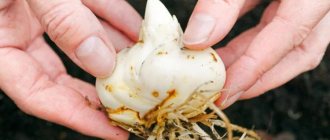Why do you need to replant tulips?
It is recommended to replant the bulbs of species tulips annually, especially for double varieties.
Ordinary representatives of the species, without transplantation and loss of decorative qualities, grow in one place for no more than 3 years. The procedure can prevent the degeneration of the variety. Without long-term transplantation, the tulip bulb becomes overgrown with numerous children, which impair the access of nutrients to it; it is important to promptly separate new roots and plant them separately
The dug up roots are sorted, sorted, the largest ones, without signs of infection, are selected for replanting in the spring, and the children are separated from the mother bulbs for their further germination. Planting material is also treated with fungicides to prevent infection by fungi.
The soil in the flower garden sags significantly under the influence of precipitation; if the tulips are not replanted, the roots deepen, and the flowering of the crop becomes sparse and short-lived.
The reason for replanting tulips in the spring may be if they change for the worse. If flowering becomes sparse and short-lived, the stem and leaves become twisted, the flowers are moved to a new location.
When to plant in open ground in autumn
Ideally, peeled and sorted bulbs are stored at the dacha in a cool (optimum temperature is 18-20°C) and dry place during the summer. They can be planted again starting in September. Gardeners should analyze temperature conditions before planting. The guideline for when to plant tulips in open ground in the fall is the 10-degree indicator. If the temperature is higher, the bulb will quickly take root and germination will begin; if it is lower, then, on the contrary, it will not take root well. In both cases, you should not expect good spring flowering; even the death of the plant is possible.
Autumn planting of tulips
Transplanting tulip bulbs in autumn has an advantage over spring. Then you won’t have to wonder why the transplanted tulips don’t bloom. Usually, transplanted plants bloom in the spring only the next year.
Important! The bulbs take root in about 30 days. Therefore, when planting in spring, it is necessary to take into account temperature and time factors. As a rule, there is not enough time for good adaptation.
When to replant tulips: in spring or autumn
The timing of tulip transplantation is influenced by a number of factors.
Among them:
- climatic and weather features of the region;
- plant development phase;
- characteristics of a particular variety (in particular, early or late flowering).
The general ideal option is usually considered to be an autumn transplant, which is carried out at least 30-40 days before the predicted first snow. In central Russia this is usually the period from the first ten days of September to mid-October. For northern regions with early winters, the optimal timing is usually limited to mid or late September.
The possibility of transplanting tulips in the spring is determined by the following rule: the soil temperature at a depth of 10 cm should be + 8-9 °C. In temperate regions this is around mid-March and early April. In the northern regions, suitable conditions can be expected longer, until the beginning of May.
It is not allowed to transplant during the following periods:
- Just before flowering. If at this stage the plant needs to spend additional effort on rooting, this can lead to its weakening and general deterioration of its condition. It is best to wait until the tulips have bloomed.
- Late autumn, at the stage of the onset of severe frosts. The bulbs will not have enough time to properly prepare for wintering in the ground and the risk of their death will greatly increase.
Storage methods
Prepared and sorted rhizomes should be stored in containers where free air circulation is possible. These requirements are met by wooden boxes, plastic containers, egg boxes, and thick cardboard boxes with holes made in advance.
Attention! If the storage container is closed, then the ethylene released by the tulips begins to accumulate in it. And it has a detrimental effect on the viability of flowers.. The bulbs must be laid out in one layer so that they do not touch each other
To avoid the development of infectious diseases, boxes must be ventilated weekly. If the first signs of the disease appear, then the affected area, provided that it is not large, must be cut off with a sharp knife and then sprinkled with ash or treated with hydrogen peroxide. If the affected area is large, then you need to get rid of the bulb
The bulbs must be laid out in one layer so that they do not touch each other. To avoid the development of infectious diseases, boxes must be ventilated weekly. If the first signs of the disease appear, then the affected area, provided that it is not large, must be cut off with a sharp knife and then sprinkled with ash or treated with hydrogen peroxide. If the affected area is large, then you need to get rid of the bulb.
If you cannot plant flower rhizomes before autumn, there are various ways to store them. The main condition for winter storage is stratification. If you neglect it, then after planting the flowers will not appear.
The most popular methods for preserving bulbs:
Wet germination. He suggests that wet sawdust or high peat should be placed in plastic containers. Place planting material on top of it and sprinkle with a little substrate. Store in the cellar. If tulip bulbs sprouted in this way, they will bloom at the usual time. Dry storage. If there are only a few rhizomes, they can be stored in the refrigerator in the compartment for fresh vegetables until planting. Each unit must be wrapped in paper. Optimal storage conditions are also available in the basement.
But for this it is important to sprinkle the bulbs with sand or dry sawdust. Crops planted in spring begin to bloom later. Early forcing
This method is suitable if there is a risk that the tulip will not be preserved in the usual way. According to it, the bulbs need to be planted in a container with garden soil. Until the first frost, you can store them on the balcony or veranda, and then cover them with film and lower them into the basement. Ventilation is necessary every 14 days, watering is needed as the soil dries out. As soon as the first shoots hatch, the container must be exposed to light.
But even if you ensure proper cultivation and proper care, there is still a high risk that the planting material will not “survive” until the next planting. Therefore, it is necessary to observe the deadlines and not store the bulbs for winter storage.
Storage locations
Rhizomes that have already been sorted and cleaned should be placed in a dry, warm and well-ventilated room. This could be an attic, a barn, a cottage. Before planting in the fall, they will be stored there at a temperature of 25 to 28℃.
In city conditions, storage of bulbs can be organized on the balcony. But at the same time it is necessary to exclude direct sunlight from hitting them. It is acceptable to keep boxes on the windowsill. In country houses, tulips are often stored in the attic. At the same time, they must be placed so that access to rodents is limited.
Conditions for tulips
In the case when tulips are intended for autumn planting, the storage temperature should be 23-25℃ plus at the beginning of planting, and before planting the bulbs this figure should be reduced to 15℃ above zero.
The humidity level should be optimal - 60-70%. If this indicator is lower, the fleshy membranes of the rhizome will shrink, so there must be ventilation and protection from direct sunlight.
Popular articles How to distinguish a white milk mushroom from a violin and a podgruzda
Attention! If this happens, the air in the storage should be slightly humidified.
If there is an excess of it, earlier germination will occur, as well as the proliferation of putrefactive microorganisms. The room used for storage must be well ventilated.
How to replant a blooming tulip
It is highly not recommended to transplant tulips during flowering. Such a plant will be much more difficult to take root in a new place. In addition, interfering with the natural development cycle of the bulb can negatively affect the formation of sprouts and flowering next year.
Important! Varietal tulips are especially difficult to tolerate transplanting during this period.
If there is still a need to replant a flowering plant, it is recommended to act according to one of the following scenarios:
- Remove the tulip from the soil along with the bulb. Carefully rinse it from the ground without cutting off the head, place it in water and wait until the plant blooms. After this, air dry the bulb and store it until a convenient time for planting in the ground arrives.
- Carefully dig up the plant along with a large lump of earth using a garden fork or bayonet shovel. Transfer to a new, previously prepared place, and water generously.
Blooming tulips do not tolerate transplantation very well, so it is best to wait until they bloom
After flowering
Tulips usually fade by summer. The replanting period after flowering falls in September. Moreover, this option is ideal, since this period is considered the most gentle for plants. The first bulbs can be dug up already in mid-July. At this time, their scales become a characteristic light brown shade. This moment should not be missed, as the plant takes new roots very quickly. In this form, replanting tulips is much more difficult.
The bulbs removed from the ground are left to dry either in the open air or indoors. At the beginning of autumn they are cleared of husks and existing stems. Make a weak solution of potassium permanganate in a separate container. Flower bulbs should be kept in this solution for some time. This procedure will protect the plant from diseases and pests in the future. All that remains is to dry the bulbs again and plant them in open ground.
You should pay close attention to the landing site. The plot of land or flowerbed should be located on a windless area, but with direct and abundant access to sunlight. Before planting, the soil needs to be additionally fertilized. Autumn is considered the ideal time to transplant tulips.
How to prepare a bulb for transplantation
To transplant tulips in the spring, planned in advance, the material is prepared in the summer. After waiting until the end of June or the beginning of July, when flowering ends and the leaves and scales of the bulb turn yellow, the plants are dug out of the ground. Then they are cleaned of adhering soil, dried in a warm room for 3-4 weeks and sorted by size, discarding damaged or rotten specimens.
After this, the bulbs are wrapped in paper with holes for aeration and stored in the vegetable compartment of the refrigerator. In the spring, a couple of weeks before the planned transplant, they are placed in wide boxes or containers filled with about 15 cm of nutrient soil. The bulbs are carefully laid out at a distance of 4-5 cm from each other, sprinkled with a 5 cm thick layer of earth and watered. 2 weeks after the sprouts appear, the tulips are transplanted into open ground. With this approach, plants do not require long-term adaptation; they will actively develop and flowering will begin on time.
Sometimes there is a need to urgently replant tulips; this can be caused by pests or depleted soil. In this case, it is not advisable to dig up the bulbs one at a time, but it is better to move them to a new place along with a lump of earth on the roots.
It is most convenient to replant already rooted tulips in the spring, moving them to another place along with a large lump of earth on the roots
How to prepare the soil for replanting
The site for transplanting tulips is selected according to the following criteria:
- well lit by the sun;
- protected from wind and drafts;
- with light, nutritious, neutral, well-drained soil.
It is important that the bed does not become flooded after the snow melts. Ideally, it should be located on a small hill (if necessary, you can add a little soil).
Advice! A few days before transplanting tulips, it is recommended to carefully dig and loosen the soil in the garden bed. This will saturate it with air and promote good rooting of plants.
During the digging process, organic matter (humus or chopped grass) is added to the soil. If the acidity of the soil is high, ash will help reduce its level. If the soil is clayey or too heavy, it won’t hurt to dilute it with coarse river sand. If necessary, you can enrich the soil with minerals (compositions containing nitrogen, phosphorus, potassium).
Rules for replanting tulips
Tulips need to be transplanted to a new place once every 3-4 years. If this is not done, the bulbs will begin to grow, forming “babies”. This will have a bad effect on flowering, the plants will begin to lag in growth and gradually lose their inherent beauty.
If spring replanting is planned in advance, it is best to pre-germinate the bulbs in a container indoors
Transplanting tulips in spring has its own characteristics. It is advisable to adhere to certain rules:
- It is recommended to transplant tulips in sunny, dry, windless weather.
- Mother bulbs and “children” separated from them are best placed in separate beds, since the latter will definitely not bloom this year, since they need to grow up.
- You need to dig grooves or separate holes in the soil. Their depth should approximately correspond to the three sizes of bulbs that are planned to be planted. The distance between the holes should be 10-15 cm.
- Before transplanting tulips, you should water the holes with water and wait until it is absorbed into the soil.
- The bulbs need to be carefully placed in holes or grooves with the “tails” up. Large specimens are planted one at a time, small ones can be planted in several pieces (from 5 to 7).
- Sprinkle the bulbs with soil and gently water with warm water.
- Level the soil in the garden bed.
Warning! It is not advisable to transplant tulips into an area where nightshade or other bulbous crops previously grew.
Spring planting
Transplanting in the spring, of course, is not the most desirable, but when there is no way out or the circumstances are so, it is important to know how to do it correctly. So, first you need to select the most beautiful and healthy bulbs and plant them in a container with prepared soil. Choose the container very carefully: its depth should not exceed 15 cm. It is better to carry out the transplantation process by the end of April.
You can replant tulips in the spring
When planting bulbs, try to maintain a minimum distance of 3 cm between them. After planting, be sure to sprinkle them with a few centimeters of soil and water them carefully. When the first shoots appear, you can plant the plant in open ground.
Advice. If the tulips have already begun to bloom, it is not advisable to replant them, since many varietal plants react quite sharply to this process. If the circumstances are this way, then try to act as carefully as possible: dig up each flower with a large lump of earth, carefully move it to a new place. Fill the holes with soil without compacting it. Water lightly.
Autumn planting
As for autumn planting, as mentioned earlier, this is the most gentle option for tulips. So, start replanting approximately by mid-July. At this point, the scales on the bulbs will turn brownish. Try not to be late, otherwise the plant will begin to take root, and then the replanting process will become much more difficult. Leave the dug up bulbs to dry either in the fresh air or in a well-ventilated area.
Tulip bulbs
At the beginning of autumn, dry bulbs must be thoroughly cleaned of husks and dry stems, kept in weak potassium permanganate to protect them from pests and diseases, dried and planted in the ground.
Remember, the area for transplantation should be virtually windless and sufficiently lit. The soil must be fertilized on the eve of planting.
That, in principle, is all you need to know about the intricacies of transplanting tulips to a new place. Good luck!
Digging up the bulbs
Many gardeners make a serious mistake - they start replanting tulips immediately after digging them up. The tubers remain in the soil all summer. It would be correct if you leave the plants until the deciduous part dries out by 2/3. After which the planting material is dug up and stored in boxes for several months. And when autumn comes, they are transplanted to a new place.
Drying
The dug up bulbs are cleaned of old scales and roots, and the children are also separated. Planting material is sorted by variety and placed in boxes. It is not advisable to cover them. Until September, the indoor temperature should be up to +20 degrees. A few weeks before landing, it is lowered to +15 degrees.
Once every few weeks it is worth inspecting the bulbs. If they show signs of damage, for example, mold or rot, then such specimens are separated from healthy ones. Mold is wiped off with a dry cloth and then treated with a fungicide solution. If the rot is small, it is cut off and the cut area is treated with brilliant green. If the tuber is severely damaged, it is thrown away.
Pre-planting treatment of bulbs
Immediately before planting in a permanent place, the planting material is treated in a weak solution of potassium permanganate. The bulbs are immersed in water for 30 minutes. After which they are dried and transplanted to a new place. Before planting in a new place, it is worth preparing the soil. The soil is dug up to a depth of 20 cm. Then the soil is watered with a solution of potassium permanganate to disinfect it.
How to determine the need for a transplant
If you carefully care for your flower beds, then you should not fanatically move tulips to a new place. It is quite possible to wait a year or two. But there are a number of signs by which one can confidently judge that there is an urgent need for the procedure. The appearance of the plants will tell you this without words, so they need to be inspected regularly.
Table 1. Signs of the need to replant tulips
| What's happening? | Causes |
| No flowering | Wrong place for planting: too sunny or shady, dry, with poor soil |
| Too many leaves and not enough flowers | There are not enough fertilizers and organic compounds in the soil, and those that are removed artificially are not enough |
| Irregular shape or color of buds | The soil is highly acidic or has an unsuitable chemical composition for tulips |
| Excessive growth | You need to get rid of some of the plants or transplant the excess rosettes to another place, dividing the flowers into two parts |
| Yellowing and wilting of leaves | Infection of the soil or plant with pests and diseases; you need to get rid of damaged specimens, disinfect the bulbs before replanting, and dig up the soil |
| Bulb rotting | Excessive watering or swampy area, tulips need to be transplanted to another place, after drying well |
Sick plant
When is the best time to replant?
There is no consensus on what time a transplant is most desirable. Some experts tend to consider the autumn months (from mid-September to mid-October) to be the best period for the procedure, while others prefer spring (before flowering begins). However, most gardeners, based on experience, advise starting from the climatic characteristics of the region.
In autumn, it is better to replant plants in areas with cold and long winters: they will have time to take root and prepare for flowering. Spring replanting is a good choice for southern regions, where warm weather sets in early, so even bulbs moved to a new location quickly adapt and throw out flower stalks.
Tulips dug up for replanting
In order for the engraftment process to be completed as quickly as possible, you can dig up the tulips from the old place in advance and put them in containers with soil for the winter, and when the weather warms up, move them to the garden bed.
You need to dig up bulbs for replanting from dry soil. By that time, the plants should have completely bloomed, if we are talking about the autumn period, or they should not throw out their flower stalks yet - in the spring. The root system should be transferred to a dry and dark place with a temperature of no more than 30 degrees and allowed to rest.
The weather during planting should be rain-free. snow and strong wind
It is advisable to review the reports in advance; special attention should be paid to forecast snowfalls, which could destroy new plants. The soil temperature should not fall below 8-10 degrees
Blooming tulips are replanted only as a last resort
In summer, tulips are not replanted because they are already in bloom. At this moment, the plant’s life cycle is at its peak of activity, and it is highly not recommended to interfere with it from the outside. Such actions can not only interrupt flowering, but also disrupt the process of laying flower buds for next year. It is also undesirable to move plants to a new location immediately before flowering, when the peduncle has already formed and is preparing to throw out the buds.
But in extreme cases, this rule can be neglected. If you see that the plant is not feeling well in the chosen place, if it suddenly begins to flood or is attacked by pests, then you should not wait until the end of flowering. You need to very carefully remove the bulb from the soil along with a lump of earth. Neither the leaves nor the peduncle are removed. The root system is carefully washed, then placed in a container with water and left in it until the end of flowering, after which the tulip can be transplanted into the soil.
Further care of plants
After an autumn transplant, sprouts appear in the spring, after the snow melts. Depending on the region, this may be the end of March-April. In May, plants are already blooming in most areas.
Plant care:
- If mulch was added to the flowerbed in the fall, it is immediately removed so that the soil warms up faster in the sun.
- After the seedlings appear, the soil around them is carefully loosened.
- Until the buds begin to appear, it is not advisable to water the flowerbed frequently; abundant irrigation is carried out after the plant enters the flowering phase.
- Fertilizers are applied to the soil only in the first half of the season, when the plants are just beginning to actively grow (you can apply any fertilizers for flower crops).
When applying fertilizing, it is worth monitoring the external condition of the flowers. If you overfeed tulips, they will begin to actively increase their leaf mass and stretch upward. Nutrients are added no more than 2-3 times per flowering season.
What to do immediately after flowering
After the tulips have faded, only dried flowers need to be cut off, if they have not previously been cut for placing in vases. The stems and leaves are not cut off until they turn yellow.
Tulips in the garden
This way the bulb can gain strength for flowering next year, and premature pruning stops its development. It is from the leaf that the onion receives a supply of nutrients to survive in the dormant phase and prepare for the new growing season.
Top dressing
Basic care for this flower involves regular feeding.
After the sprouts appear, the soil is fertilized with nitrogen-containing preparations, which promote intensive growth of shoots and leaves.
Before flowering, it is not necessary to fertilize tulips, although some gardeners apply complex mineral fertilizers once.
Re-feeding with nitrogen and phosphorus-potassium preparations is carried out during the budding period. The last feeding of decorative flowers is done after the end of flowering - phosphorus and potassium are added to increase the immunity and winter hardiness of plants.
In autumn, beds with bulbous ornamental crops should be covered with burlap, hay or film. You should take care of covering material in advance: there is no guarantee that frosts will not occur earlier than predicted. In the spring, it is also advisable to use it when there is a sudden drop in temperature, which often happens even in the middle zone, not to mention the northern regions.
Before replanting in the fall, the soil is mulched. In spring, the plants are practically not watered until the buds appear. Tulips will only need the moisture that remains in the soil after the snow melts. As soon as the flowers appear, pay attention to their appearance - deformed specimens with signs of degeneracy of the variety should be dug up and destroyed. With further transplantation they will degrade even more. The soil around the entrances should be loosened to provide oxygen access to the roots.
Do not water tulips immediately after transplanting
Care after transplant
The future development of the tulip depends on what care is provided to the plant after transplantation.
We recommend reading about the violet variety Magic Tulip.
The details of this procedure can be divided into several important stages:
- The soil surface is compacted and compacted. Mulch the soil. For this, sawdust or fallen pine needles are used. Such care guarantees the safety of the bulbs during the winter.
- It is necessary to plant according to varieties.
- If there is no rain during this period, the soil should be constantly moistened. As soon as frost appears, this process should be stopped.
- After the first shoots appear above the surface of the earth, they should be carefully examined. Remove those that are damaged or infected. All rejected material is destroyed, as it can harm the entire plantation.
- The soil is constantly loosened. This will allow the root system to receive a constant supply of oxygen. This effect has a beneficial effect on the growth and development of the plant. This procedure is repeated after each watering or precipitation.
- Constantly add a small amount of water. Frequent watering makes the flower bed waterlogged. Excessive moisture leads to rot. Slightly increasing the watering rate is allowed only during the flowering period.
- After the first shoots appear, fertilizing should be done. The presence of nitrogen in fertilizers is mandatory, since it is this element that improves the growth and formation of leaves.
- During subsequent plant growth, fertilizing is not needed. It is only possible to apply complex fertilizer with useful microelements.
- At the moment of formation of the first buds, a second feeding with nitrogen-containing and phosphorus-containing substances is often carried out. During this period, tulips require more nutritional components.
- The last feeding of the plant is carried out when the last blossom falls. At the same time, fertilizers should contain potassium and phosphorus, but not nitrogen.
Storing and preparing tulips for planting
To achieve abundant flowering of tulips the next year after digging up their tubers, a number of necessary preparatory works should be carried out:
- Free the bulbs from soil and husks.
- Discard diseased and damaged plants.
- Separate the daughter small bulbs from the mother bulbs.
- Sort the tubers for future planting by size.
- Carry out disinfection in a solution of potassium permanganate (per 10 liters of water - 1 g of powder).
- Dry well in a dark, ventilated area.
- Provide storage until autumn in a dry, warm place.
In autumn, a place for flowers is selected. It should be elevated and not floodable during spring snowmelt.
The soil is fertilized with ash, mown grass, humus and dug up. With well-fertilized soil, plants can be planted in the same place.
Before planting, grooves up to 10 cm deep are made in the prepared beds. The distance between them should be at least 13-15 cm.
At the right time, the tubers are planted in the ground and sprinkled. Experienced gardeners advise planting small bulbs first and only a week later planting large ones. This should ensure friendly shoots in the spring. From frost, the top of the bed can be covered with dead wood, fallen leaves or dry grass.
If everything is done correctly, then in the spring, immediately after the snow melts and the earth warms up with the sun's rays, identical tulip sprouts will appear, which will delight you with beautiful selected flowers in the future.
What to do with dug up tulip bulbs
It is important to know how to properly preserve bulbs.
They are sorted by variety - diseased or rotten ones are folded separately and scattered in boxes or cardboard boxes, thereby ensuring good ventilation. For 2 days they are left to dry in a shaded place. When the onions dry out a little, the old scales are removed from them, the remaining soil and roots are removed, and the undisintegrated heads are separated. It is best to clean with paper towels to avoid damaging the protective layer.
Attention! If you had to dig up the bulbs in the rainy season, you need to rinse them under running water. To preserve the bulbs from diseases and pests and restore manganese reserves, they are soaked in a weak solution of potassium permanganate for half an hour
Fungicidal preparations are also suitable: Vitaros, Maxim, Fudnazol
To preserve the bulbs from diseases and pests and restore manganese reserves, they are soaked in a weak solution of potassium permanganate for half an hour. Fungicidal preparations are also suitable: Vitaros, Maxim, Fudnazol.
You can prepare a simple disinfecting solution: 1 tsp. salt and 1 tsp. soda per 1 liter of water.
After processing, the onions are left to dry for 5-8 days.
Pickled, dried onions are sorted by their diameters:
| List of professions | Regulatory issuance procedure |
| Builders | signal form; gloves; PPE for face and ears; Vibration reduction products |
| Drivers | mittens; warm suit; safety shoes |
| Loaders | overalls; gloves; jackets; trousers. |
| Sales staff | headscarves; gloves; robes |
| Agricultural employees | gloves; shoes; mittens. |
| Electrical workers | dielectric special gloves; safety shoes; headdress; outerwear; thermal underwear for dielectrics. |
Prepared onions are left in a ventilated area without drafts or direct sunlight. Ventilation is necessary to protect the heads from rot and mold. They should not be covered: this promotes the production of ethylene.
They are periodically reviewed and those that are rotten or affected by disease are removed. If a spot of rot appears on a good onion, you can remove it with a disinfected knife and treat the cut area with crushed charcoal.
To remove excess moisture, the bulbs are sprinkled with sawdust or covered with newspapers. An interesting idea is to store the bulbs in egg trays or mesh bags.
Tray
Important! The heads should not be stored near the fruit: they emit ethylene, which kills the flower embryos. For proper ripening, it is necessary to maintain the desired temperature.
In July, 23-25°C is required, in August it is reduced to 20°C, in September to 15-17°C. This promotes the formation of a flower bud. Failure to comply with the temperature regime leads to the formation of blind buds (they dry out unopened). There are a number of reasons for this, including improper training and illness.
For proper ripening, it is necessary to maintain the desired temperature. In July, 23-25°C is required, in August it is reduced to 20°C, in September to 15-17°C. This promotes the formation of a flower bud. Failure to comply with the temperature regime leads to the formation of blind buds (they dry out unopened). There are a number of reasons for this, including improper training and illness.
The air should not be too dry or humid: in the first case, the bulbs will die, in the second they will begin to rot. The optimal percentage of humidity is 60-80%. If the bulbs wrinkle, they are sprayed with water from a spray bottle.
Important! They should not be stored in the basement or refrigerator.
Storage
How to preserve bulbs before planting
After excavation, the necessary requirements for temperature, humidity and ventilation of the room for storing planting material should be strictly observed.
It is important to preserve the bulbs until autumn
Particular attention should be paid to maintaining temperature conditions. This is very important for the further full development of the plant.
Bulb storage rules
Let's consider methods for processing flower bulbs and the rules for storing them until the next planting. Having figured out when to dig up tulips after flowering, you should take care of the planting material. The bulbs should be placed in trays and provided with ventilation.
Popular articles Amaryllis - home care after floweringIf the weather is sunny and dry, it is better to take the boxes outside to dry and leave them there throughout the day. When putting the bulbs indoors, you should clean them of excess scales and dirt, after which they are washed in a saline solution - prepared at the rate of 1 tablespoon of salt per 1 liter of water. This will help protect them from pests and diseases during storage. All planting material is placed in layers in containers.
The bulbs should be stored in a dark room with good ventilation; it must be prepared and disinfected in advance. Temperature and humidity levels are of great importance for tulips. In mid-summer, the first 28 days after storage - the temperature should be plus 21-25 degrees Celsius, and the humidity level should not rise above 65%. It is recommended to ventilate once every 2-3 days, approximately 3-4 hours. Such conditions will help prevent rotting and mold on the bulbs.
Closer to August, the temperature is lowered to plus 19 degrees Celsius, and by September - to 16. Accordingly, the ventilation time is also reduced. At the right temperature conditions, buds and leaf buds are formed. Do not forget to inspect the bulbs, if you find bad or infected ones, discard them so that they do not infect others.
Basic mistakes
Below are examples of the most common mistakes made when replanting tulips.
Timely familiarization will prevent their recurrence and ensure the safety of the plants being grown:
- Carrying out transplantation during the growing season. Even if this procedure is urgently required for objective reasons, it is necessary to wait until the end of this period, otherwise the plants may not be able to transfer to a new location.
- Transplantation is carried out directly during flowering. This not only negatively affects the condition of tulips and worsens their adaptation to a new place, but also disrupts the natural development cycle of plants. Even if the bulbs survive the winter without problems, they may not bloom the next season.
- Removing the flower if for some reason the bulb was removed from the ground along with the blooming tulip. To minimize harm, it is necessary to place it in an aquatic environment and wait until flowering finishes naturally.
- Storing bulbs before transplanting at temperatures above +30 °C. Such conditions are considered unacceptable, since they often lead to the complete loss of flower buds.
Reasons for replanting tulips
It is recommended to replant flowers annually for several reasons, namely:
- preservation of plant varietal characteristics;
- slowing down the rapid development of the tulip;
- the planting remains decorative.
Did you know? Flower bulbs were sold very expensively in the Netherlands in
the mid-17th century . Each of them was more expensive than the house of a person with an average income. In their natural habitat, tulip bulbs grow on the mountains, and every year sewage water deepens them into the ground, which leads to the death of the plant. In garden plots, approximately the same process occurs, which is why annual replanting of tulips is so important. Then the flowering of this spring plant will delight you every year.
Tips for subsequent transplants
- If the bulbs dug up for transplantation are slightly trimmed with a shovel, then the damaged areas can be covered with activated carbon.
- Slightly rotten specimens can also be saved: you need to carefully cut out the damaged tissue, place the tulip in a solution of potassium permanganate for half an hour, remove it, dry it, and lubricate it with a disinfectant.
- Before planting, it is useful to keep the bulbs in quarantine for a month, for which they can be placed in a plastic bag along with crushed garlic cloves. In this way, flowers can be protected from diseases and pests.
- Stepchild bulbs are planted separately, as they will not bloom for another year.
- It is worth marking the transplant site so that you know exactly where the flowers are now and do not forget about them.
When transplanting tulips into flower beds, varieties with large flowers should be placed in the middle, with small ones - along the edges, so that they are not blocked by other crops
- Do not use the growing season to change the soil. Tulips during this period are very sensitive to various changes and may die.
- It is necessary to choose a place for transplanting plants on the sunny side. However, when planting plants, it is recommended to avoid prolonged contact of sunlight with the bulbs, otherwise the tulips may be damaged and not take root.
- Large and medium-sized bulbs must be replanted in different places, since their flowering times may differ.
- When using several varieties of tulips, it is necessary to maintain some gaps between the beds to avoid degeneration of the variety.
Let's celebrate! Tulips are one of the earliest flowers; proper plant transplantation and care will allow you to get bright and large flowers that will delight others for a long time. Also, following the rules of care will preserve the plant variety and prevent the formation of diseases.
Some useful tips will help many gardeners avoid unpleasant consequences when transplanting these flowers:
- If you decide to replant tulips in early spring, then the planting material must be placed in a container with cool soil and placed in a basement or cellar for several weeks. This stratification procedure will increase the survival rate of tubers in open ground after planting.
- If possible, drying the bulbs before transplanting should be done outside, but without direct sunlight.
- During the transplantation process, adult tubers should be sorted from their children and planted in different places, since their flowering periods are also different.
- Tulips can be dug up and planted along the daffodils. These flowers grow very well and go together very well. Tulips bloom immediately after the daffodils fade.
Deadlines
It is recommended to dig up tubers at the end of flowering of the plant and yellowing of the leaves and stem . There are many varieties of tulips, differing from each other in the appearance of the flower and the timing of flowering. Early varieties bloom already at the end of April, so preparations for the next season in the form of digging up tubers can begin at the end of May. Tulip bulbs of mid-early varieties are dug up in June, and late ones - in early July.
The timing of planting bulbs in the ground depends on weather conditions and the area where the flower grows.
It is not recommended to plant in the ground when the soil temperature is above 10°C due to the high probability of rapid germination of the plant and its freezing during the first frost.
Some gardeners practice replanting in early spring. However, in this case you should not hope for flowering this season.
Also, if necessary, you can replant the tulip during the active flowering phase. In this case, it will not be possible to preserve the buds and flowers.
Let's sum it up
When growing tulips in the garden, you cannot do without replanting. Without this procedure, the plants will die in a maximum of 3-4 years. It is recommended to do it at least once every two years, and even when the tulips clearly need it, as evidenced by the unsatisfactory appearance of the flowers. The bulbous crop should not be replanted during the flowering period and in the summer; this should be done in spring or autumn.
The choice of the most favorable period depends on many factors, and primarily on the climatic characteristics of the region. Both spring and autumn transplants have their advantages and disadvantages. The latter can be neutralized if you follow the rules and recommendations of specialists.
Sources
- https://u-florista.ru/tyulpan/mozhno-li-peresazhivat-tyulpany-do-tsveteniya-vesnoy.html
- https://fermilon.ru/tsvety/odnoletniki/mozhno-li-peresazhivat-tyulpany-vesnoy-do-tsveteniya.html
- https://gruppa-pm.ru/kogda-nuzhno-peresadit-tyulpany/
- https://sad24.ru/cvety/mnogoletnie/kogda-mozhno-peresadit-tyulpany.html
- https://DachaMechty.ru/tsvety/tyulpan/peresadka-osenyu.html
- https://zen.yandex.ru/media/id/5c169e6f87f1e000ac197a44/5cde975339169100b31a089b
- https://greensotka.ru/lukovichnye/kogda-peresazhivat-tyulpany.html
- https://vogorode.com/flowers/mnogoletnie/peresazhivat-tyulpany.html
[collapse]
Tulip development cycle
In early spring, when even trees and bushes are just beginning to be covered with delicate greenery, tulips are already spreading their elegant petals and pleasing to the eye. And later, when other ornamental crops begin to bloom, the bright buds are not lost in the flowerbed, but continue to attract the eye. But in return, these flowers require a lot of attention. They must not only be planted correctly, but also regularly replanted.
The entire life path of this decorative bulbous crop can be divided into two large periods: rooting in the soil after planting and flowering.
Tulips ready to bloom
The cyclical nature of the life process is subject to natural seasons: the sowing of bulbs is usually carried out in the autumn months, during the winter the flower gains strength, takes root, grows stronger, so that in the spring it quickly grows, produces leaves and then buds. After flowering, development stops for a while while the plant accumulates nutrients. Then everything repeats.
If tulips are not replanted, as happens in the wild, then every year the bulbs go deeper into the ground, trying to draw more nutrients from it and safely overwinter. Ultimately the plant dies.
The same thing will happen in the garden if you leave the flower to its fate. Therefore, you cannot do without a transplant; the only question is how often and at what time it needs to be done.
Life cycle of a tulip
Why else is a transplant needed?
“Self-digging” is not the only reason why tulips should be replanted. The soil or lighting in the chosen location may not be suitable for them. Perhaps the flowers will not like the proximity to some garden crops, and they will begin to wither for no apparent reason. You should not discount mistakes made during the first planting, due to which the bulbs were damaged; then it is also better to replant them, correcting all the shortcomings.
It is recommended to carry out the procedure every year or at least once every 2-3 years. Flowers will not survive on the site for more than 4 years without replanting. Transferring a bulbous crop to a new location contributes to:
- preservation of varietal characteristics (this is especially true for expensive hybrids and valuable ornamental varieties);
- inhibiting the rapid growth of leaves, which harms the formation of flower stalks;
- improving the health of plants, weeding out diseased, degenerating specimens;
- correct design of flower beds, if you decide to change the composition of the crops for them, you will have to think about how to most advantageously place the tulips and combine them with their neighbors.
Tulips in a flowerbed in combination with other flowers
Features of the transplant procedure
Whatever period is chosen for the transplant, in general it is carried out using the same method. First you need to make sure that the plant is still or no longer blooming, for which it is carefully inspected. In the spring, bulbs prepared in advance from the summer are selected, and in the fall, plants with yellowed and dead leaves are dug up.
Suitable specimens must be kept in quarantine for about another month - in a dry, cool, well-ventilated room, without direct sunlight. You need to make sure that the tulips do not rot, deteriorate, or be exposed to pests.
You can only plant dry onions
After drying, the bulbs are carefully freed from remnants of scales, old soil and dead roots. Next, you should sort them by type and size, because large and small samples need to be planted separately. When replanting in autumn, the plants are immediately placed in the garden bed. In spring: either first sprouted in containers, or stored in a special way.
Before you dig up tulips from an old place, you must choose a new one and prepare it properly. You need to remove plants from the ground very carefully, without leaving behind the shoots that will hatch again in the spring. To ensure that all the bulbs are selected, you should check the area using a garden fork.
From the former garden bed you need to carefully select all the bulbs along with their stepsons
Soil preparation
A new place for flowers must be chosen especially carefully, especially if they did not grow well in the old area. Perhaps it was all due to poor soil or inappropriate lighting. Then these shortcomings should be eliminated first. Tulips do not like wind, so the planting needs to be protected from it with a fence or taller plants near the bed.
The bulbous culture belongs to the group of heat-loving ones, so it needs a well-lit area. And flowers also need good watering, but without excessive waterlogging of the soil, so low-lying places are not suitable.
When replanting, the soil is prepared and fertilized in advance
The soil for replanting needs to be loosened well and slightly moistened if it is dry. Sand should be added to clay soil (20 kg per 1 sq. m). It is also necessary not to forget about fertilizers if we are talking about the spring period. There is no need to fertilize in the fall so that the tulips do not immediately begin to grow. The procedure must be postponed until March. You can fertilize in advance - a month before the intended transplant, if you have already decided on a new location. A mineral complex with superphosphates and potassium salt is added to the soil.
Landing technology
The bulbs begin to be planted in pre-prepared soil with a temperature of no more than 9-7 degrees. The plants will be placed to a depth of approximately ten centimeters. The distance between flowers should be 9-10 cm (for large specimens) or 7-8 cm (for smaller ones).
Before planting in the ground, dead scales and roots are cut off from the bulb. Damaged and rotten samples are thrown away, only healthy and undamaged specimens are used.
Bulbs are planted at a distance from each other
Table 2. How to plant: step-by-step instructions
| Illustration | Description |
| Step one: make holes in the soil for the bulbs, 10-11 cm deep. | |
| Step two: sand is poured into the hole; it should be slightly moistened. | |
| Step three: place the bulb vertically in the hole so that the flower grows in the desired direction. | |
| Step four: fill the holes with dry soil mixed with wood ash (two-thirds of the soil - one-third of the ash). | |
| Step five: we place covering material on top of the bed, since in the fall it is already close to frost, and in the spring they are not yet ruled out. |
Transplantation process (step-by-step instructions)
Transplanting tulips comes down to the following:
- immediately before planting, it is advisable to treat the bulbs again with a solution of potassium permanganate;
- Closer to the time of planting, you need to dig up the soil and add fertilizers. Several days should pass from the moment of digging up the garden area where the tulips will be planted until the moment of planting;
- holes should be made in the soil approximately 10 cm deep. For large bulbs, the holes can be made deeper, for small ones, on the contrary, a little smaller. There should be a distance between the holes of at least 10 and no more than 15 cm. Your flowers should not be crowded;
- Before planting the bulbs, the holes should be thoroughly watered and wait until it is completely absorbed into the ground;
- the bulbs should be carefully placed in the holes with their tails up and sprinkled with earth;
- The bulbs covered with soil on top should be watered again with warm water;
- Carefully level the soil surface with a rake.
Advantages and disadvantages of autumn transplantation
The advantages of autumn planting are:
- Over the winter, the bulbs will have time to take root in a new place.
- Flowering times remain the same.
- After flowering, the bulbs will have time to gain nutrients.
- In spring, tulips will immediately enter a phase of active growth without adapting to a new location.
One of the disadvantages is that if you replant the crop in the fall in the northern regions, frost may suddenly strike, and then there is a high probability that the bulbs will die.
In what cases is a transplant necessary?
Tulips need to be replanted in the following cases:
- it grows in one place for too long;
- despite care, the tulip does not bloom;
- the flower has bloomed, but its petals are uneven and deformed.
If a flower grows in one place for a long time, even if it is fed and fertilized, the soil will still be depleted. And if your flower has been growing for 4-5 years in one place, and you have never replanted it, it’s time to do it.
If the flower does not bloom, although leaves appear from the ground, this is also a signal that it is time to replant the tulip. The fact is that the layer of soil becomes denser over time, and air flows poorly to the roots of the plant. The soil deteriorates due to irrigation with hard water, due to mineral fertilizers, and also due to the fact that plant roots emit carbon dioxide. As a result of all these components, the tulip lacks nutrients, and it reacts to this by not blooming.
The need for urgent transplantation is also indicated by the deformation of the petals on the flower. If the petals have uneven edges, if the tulip flowers become smaller and smaller, or the bud that appears does not bloom but turns yellow, this is a signal that the bulb should be transplanted to a new fertile place.
How to plant
Tulips are planted back into the soil in the fall. In order for the flowering to be abundant and the inflorescences to be large, you need to choose the right place and follow the rules of agricultural technology during planting.
Selecting a location
For planting, it is best to choose open sunny areas. In partial shade, flowers can also bloom, provided that the soil is nutritious and fertile. Even if tulips bloom in the shade, the flowering is very sparse.
It is also worth choosing places for flower beds that are protected from drafts. Water should not stagnate in the soil.
It is not recommended to replant planting material in the same place; it is better to choose a different area. If you plant flowers constantly in one flowerbed, the buds become small. The soil must have time to recover. Also, you should not plant tulips where other bulbous crops grew, they have the same diseases.
Selection and preparation of planting material
For planting, you need to choose healthy large bulbs without signs of damage. You can plant children, but in the first year after planting they will not bloom. Do not plant seeds that have mold or insect marks on them. Before planting, planting material can be processed. Two hours before planting, the bulbs are soaked in a weak solution of potassium permanganate. If there is no time for long-term processing of planting material, you can water the prepared holes with a solution of potassium permanganate.
How to prepare the soil
It is advisable to prepare the soil for planting the crop in advance. The soil is dug up, weeds are removed and mixed with rotted manure or complex mineral fertilizers. Before planting, you can dig up the soil again and remove all weeds if they have managed to grow. Drainage is poured into the bottom of the holes to prevent stagnation of water.
Planting scheme
The holes are dug to a depth of 10 cm. The distance between large bulbs is left up to 15 cm. A smaller distance can be left between the children. You can plant the seeds in two or three rows. The first row is the largest bulbs. Then the onions are smaller. And the very last row is the baby bulbs. With this planting scheme, all bushes will have enough sunlight. You can plant the bulbs in any order. If tall perennials or any other tall flowers grow in the flowerbed, tulips should be planted in front of them so that the bushes do not block the sun for them.
Sandwich
This method is often used for planting bulbs in containers, but it can also be used in a flower bed. The good thing about the sandwich planting method is that the tulips will bloom longer than with regular planting. You will have to dig the flowerbed in several layers.
The first layer is dug to a depth of 20 cm and the bulbs are planted. Then they are sprinkled with soil and a new row is planted. This continues until the entire hole is filled. Tulips planted in this way bloom one by one. The lower the layer, the longer the seeds will “hatch”. You can alternate not only tulips in this way, but also hyacinths along with them.
Tiers
Planting in tiers is similar to the sandwich method. Large bulbs are planted on the lowest row. And so on in descending order. The row closest to the soil surface is the baby bulbs. It should be taken into account that large bulbs grow quickly, and the plants are much larger in size than the children, so they can obscure them. It is better to plant small bulbs away from large ones.
In baskets and containers
Plants can be planted in open ground in containers. The main advantage of this method is that the bulbs will not be chewed by mice. In addition, when the time comes to dig up the planting material, it will be very easy to do.
To plant, you need to take a deep and free container, fill it completely with soil and plant the seeds. Dig a deep hole in the flowerbed so that the container fits there. Bury it with soil so that the edge is not visible.
Planting on the lawn
The advantage of planting seeds on the lawn is that you don't have to wait for the bulbs to get enough nutrients, so you don't have to wait for the foliage to completely dry out. For planting, you need to choose the same varieties or varieties with the same flowering period. It is better to plant seeds in a separate container, for example, in a container. A hole is dug in the lawn that is the size of the container. Tulips are planted in a container. They place it in a hole and bury it. You can plant the container with lawn grass so that the ground is not visible.
Preparatory work before planting tulips
Before you start planting, you need to prepare the site and the planting material itself. The quality of tulip flowering in the spring months largely depends on this.
Selecting a location
The brightness of the color and the size of the buds largely depend on where the tulips will be planted. This is a light-loving culture. If there is insufficient lighting, the peduncles will be too elongated, thin and curved, and the buds themselves will be paler than the characteristics of the variety promise.
You cannot plant tulips in lowlands, where water often accumulates in the spring. Excess moisture in the soil can easily cause bulbs to rot. It is advisable that the area be protected from winds; these flowers also do not like drafts.
Soil requirements
Soil with a neutral or slightly alkaline reaction is best suited for planting tulips. In acidic soil, the crop may produce “blind” buds (that do not subsequently bloom). The flowerbed should be prepared in advance, approximately 1-2 months before planting the bulbs. The earth is dug up on the bayonet of a shovel.
If the soil is infertile, it is fertilized. For this purpose, it is good to use a special purchased fertilizer for bulbous flowers. Experienced summer residents prefer to prepare fertilizer themselves, mixing compost, wood ash, dolomite flour, superphosphate, potassium sulfate, ammonium nitrate.
Preparing tulip bulbs for planting
Before planting, the bulbs should be carefully inspected. There should be no traces of mold or any damage on them. A high-quality bulb is distinguished by a dense bottom with rudiments of roots.
Before planting, the material must be etched. This procedure will protect tulips from most bacterial and fungal diseases. The simplest method is to immerse the bulbs for half an hour in a weak solution of potassium permanganate. You can also use Fundazol and Vitaros as a disinfectant.











